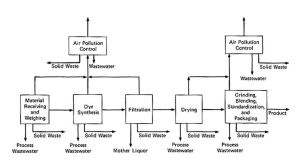CHEMISTRY OF DYES
A dye is a colored substance that has an affinity to the substrate to which it is being applied. It is an ionizing and aromatic organic compound, with Chromophores as a major component. Their structures have Aryl rings that have delocalized electron systems. These structures are said to be responsible for the absorption of electromagnetic radiation that has varying wavelengths, based upon the energy of the electron clouds.
History of Dyes
Dyes usage was started in 2600 BC in china and followed by
- 715 BC Wool dyeing established as craft in Rome
- 55 BC Romans found painted people “picti”
- 2ND and 3RD Centuries AD Roman graves found with madder and indigo dyed textiles
- 1200′s Rucellia, of Florence, rediscovered the ancient art of making purple dye from lichens
- 1321 Brazilwood was first mentioned as a dye
- 1507 France, Holland and Germany begin the cultivation of dye plants as an industry
- 1630 Drebbel produced a new brilliant red dye from sources like cochineal and tin
- 1774 Scheele discovered chlorine destroyed vegetable colors
- 1774 Prussian Blue and Sulfuric acid are started available in commercial market
- 1775 Bancroft introduced the use of quercitron bark as a natural dye
- 1834 Runge, a German chemist developed aniline dyes
- 1856 William Henry Perkin discovered the first synthetic dye “Mauve”
- 1858-59 Verguin discovered Magenta (fuchsin) dye
- 1861 Lauth discovered basic dye called Methyl violet
- 1862 Martius and Lightfoot developed Bismarck Brown
- 1863 Lightfoot developed Aniline Black
- 1868 Graebe and Liebermann produced alizarin dye
- 1872 Lauth and Baubigny developed Methyl Green
- 1873 Groissant and Bretonniere produced Cachou de Laval sulphur dye
- 1876 Methyl Blue discovered by Caro
- 1877 Dobner & Fisher discovered Malachite Green discovered
- 1878 Biebrich Scarlet invented red acid dye
- 1878 von Baeyer synthesized synthetic indigo
- 1880 Thomas and Holliday synthesized azo dye
- 1884 Bottiger discovered Congo Red [cotton dye]
- 1885 Duisberg produced Benzopurpurine direct dye
- 1885 von Gallois and Ullrich discovered Para Red dye
- 1901 Rene Bohn invented and patented Indanthrene Blue RS
- 1901 Bohn Flanthrene vat dye
- 1905 Freidlander discovered Thio-indigo Red
- 1908 Cassella developed Hydron Blue
- 1921 Bader developed soluble vat colors
- 1924 Baeyer and Sunder companies produced Indigosol 0
- 1951 Geigy introduced Irgalan dyes
- 1956 Eastman Kodak introduced Verel
- 1957 CIBA introduces Cibacrons reactive dyes
Dyeing process
Dyeing is the method of adding color to textile products like fibers, yarns, fabrics, leather, plastics, paint, printing and many others. Dyeing is normally done in a special solution containing dyes and particular chemical material.
Dyeing process of textiles
In textile dyeing process widely used chemicals like
- Acetic acid
- Formic acid
- Sodium hydroxide
- Potassium hydroxide
- Sodium hypochlorite
- Sodium chlorite
- Sodium chloride
- Sodium silicate
Classification of dyes
Dyes are classified based on following factors
- Chemical composition
- Nature of nuclear structure
- Various industrial uses
- Sources of origin
- Miscellaneous factors
Dyes which are classified based on chemical composition are
- Acridine dyes
- Anthraquinone dyes
- Arylmethane dyes
- Azo dyes
- Cyanine dyes
- Diazonium dyes
- Nitro dyes
- Nitroso dyes
- Phthalocyanine dyes
- Azin dyes
- Eurhodin dyes
- Safranin dyes
- Xanthene dyes
- Indophenol dyes
- Oxazin dyes
- Oxazone dyes
- Thiazin dyes
- Thiazole dyes
- Fluorene dyes
- Rhodamine dyes
- Pyronin dyes
Dyes which are classified based on industrial uses are
Acid dyes - water-soluble anionic dyes applied from acidic dye baths to nylon, silk, wool, modified acrylics
Azoic dyes – contains azo group
Basic dyes – water-soluble cationic dyes
Direct dyes – water-soluble anionic dyes applied to dyeing of cotton, regenerated cellulose, paper and leather
Disperse dyes – water-insoluble nonionic dyes
Reactive dyes – used in materials like cotton, rayon, nylons
Solvent dyes – water-insoluble, soluble in alcohols, chlorinated hydrocarbons, or liquid ammonia
Sulfur dyes – water-insoluble, low cost, good fastness dyes
Vat dyes – insoluble complex polycyclic molecules
Mordant dyes – used to improve the fastness of the dye against water
Dyes which are classified based on Sources of origin are
- Natural dyes
- Synthetic dyes
Dyes which are classified based on miscellaneous factors
- Fluorescent Dyes
- Oxidation Dyes
- Fuel Dyes
- Leather Dyes
- Optical Brighteners
- Leuco Dyes
- Sublimation Dyes
- Smoke Dyes
- Inkjet Dyes
- Solvent Dyes




No comments:
Post a Comment